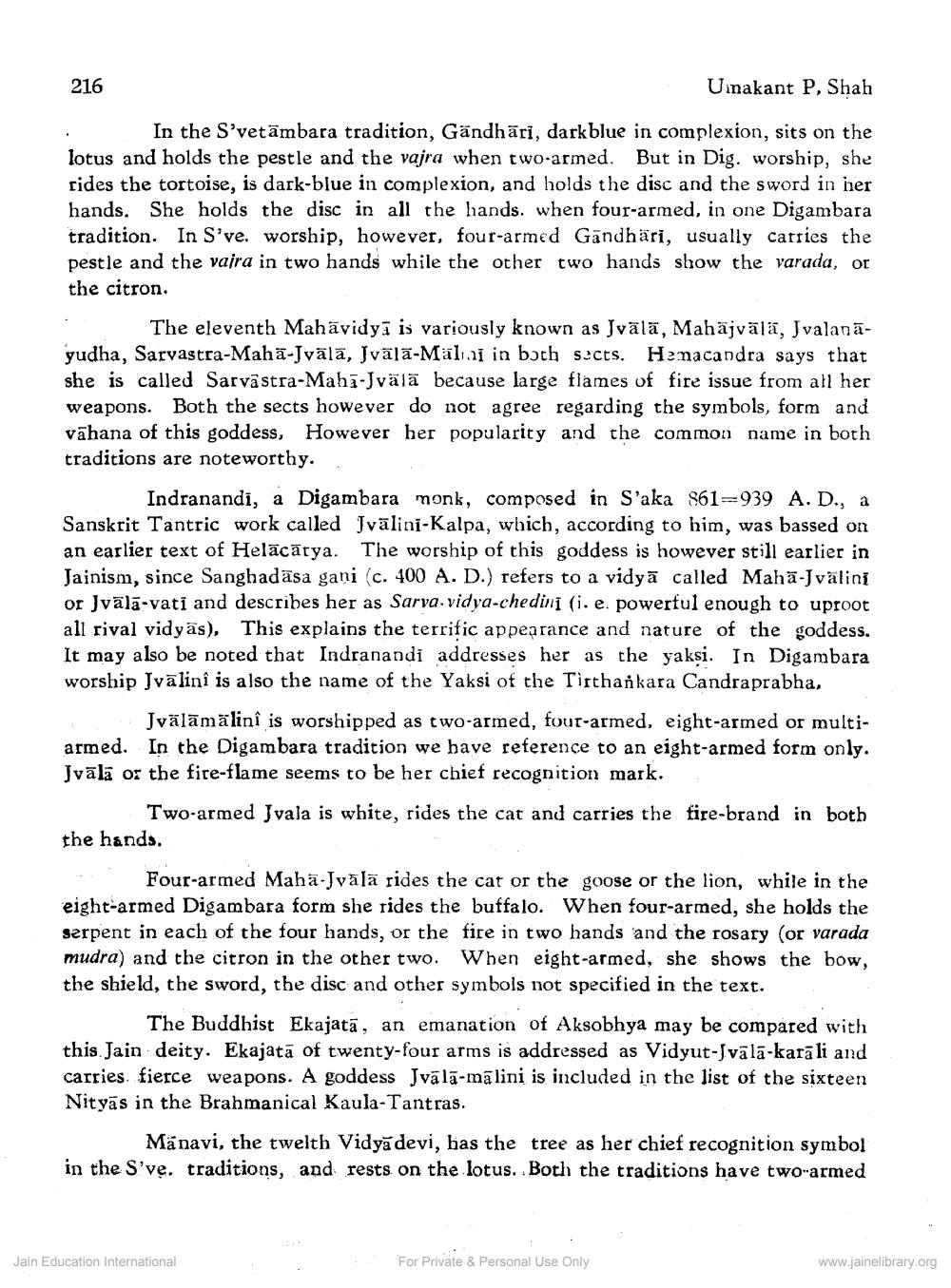________________
216
Uinakant P, Shah
In the S'vetāmbara tradition, Gändhāri, darkblue in complexion, sits on the lotus and holds the pestle and the vajra when two-armed. But in Dig. worship, she rides the tortoise, is dark-blue in complexion, and holds the disc and the sword in her hands. She holds the disc in all the hands. when four-armed, in one Digambara tradition. In S've worship, however, four-armed Gāndhäri, usually carries the pestle and the vajra in two hands while the other two hands show the varada, or the citron.
The eleventh Mahāvidyā is variously known as Jvālā, Mahājvāla, Jvalanāyudha, Sarvastra-Mahā-Jvālā, Jvālā-Mälai in bɔth sects. Henacandra says that she is called Sarva stra-Maha-Jvälä because large flames of fire issue from all her weapons. Both the sects however do not agree regarding the symbols, form and vāhana of this goddess, However her popularity and the common name in both traditions are noteworthy.
Indranandi, a Digambara monk, composed in S'aka 861=939 A. D., a Sanskrit Tantric work called Jvālini-Kalpa, which, according to him, was bassed on an earlier text of Helācārya. The worship of this goddess is however still earlier in Jainism, since Sanghadāsa gani (c. 400 A. D.) refers to a vidyā called Mahā-Jvälini or Jvälā-vati and describes her as Sarva. vidya-chedini (i.e. powerful enough to uproot all rival vidyās), This explains the terrific appearance and nature of the goddess. It may also be noted that Indranandi addresses her as the yakși. In Digambara worship Jvālini is also the name of the Yaksi of the Tirthařkara Candraprabha,
Jvälāmālini is worshipped as two-armed, four-armed, eight-armed or multiarmed. In the Digambara tradition we have reference to an eight-armed form only. Jvāla or the fire-flame seems to be her chief recognition mark.
Two-armed Jvala is white, rides the cat and carries the fire-brand in both the hands.
Four-armed Mahā-Jvālā rides the cat or the goose or the lion, while in the eight-armed Digambara form she rides the buffalo. When four-armed, she holds the serpent in each of the four hands, or the fire in two hands and the rosary (or varada mudra) and the citron in the other two. When eight-armed, she shows the bow, the shield, the sword, the disc and other symbols not specified in the text.
The Buddhist Ekajatā, an emanation of Aksobhya may be compared with this. Jain deity. Ekajatā of twenty-four arms is addressed as Vidyut-Jvāla-karā li and carries. fierce weapons. A goddess Jvālā-mā lini is included in the list of the sixteen Nityas in the Brahmanical Kaula-Tantras.
Mänavi, the twelth Vidya devi, has the tree as her chief recognition symbol in the S've. traditions, and rests on the lotus. Both the traditions have two-armed
Jain Education International
For Private & Personal Use Only
www.jainelibrary.org




